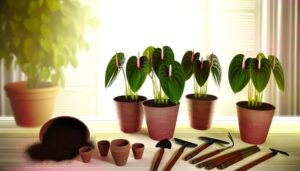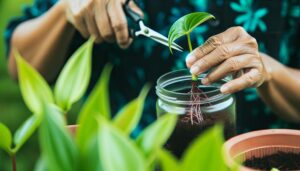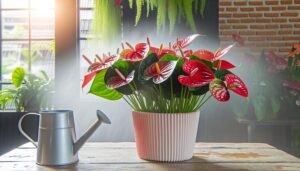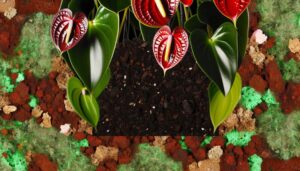Caring for Anthuriums With Brown Leaves: Essential Tips
Brown leaves on your Anthurium often signal issues with watering, humidity, light, or temperature. Make sure you’re watering thoroughly but infrequently using well-draining soil.
Maintain humidity levels between 70% and 80%, and provide bright, indirect light. Keep temperatures stable between 65°F and 80°F, avoiding sudden changes.
Check for pests and diseases, treating them promptly to prevent further damage. Regularly prune damaged leaves and assess your plant’s environment for best growth.
By addressing these factors, you can help your Anthurium recover and thrive. For deeper insights into perfecting your care routine, continue exploring information on each of these aspects.
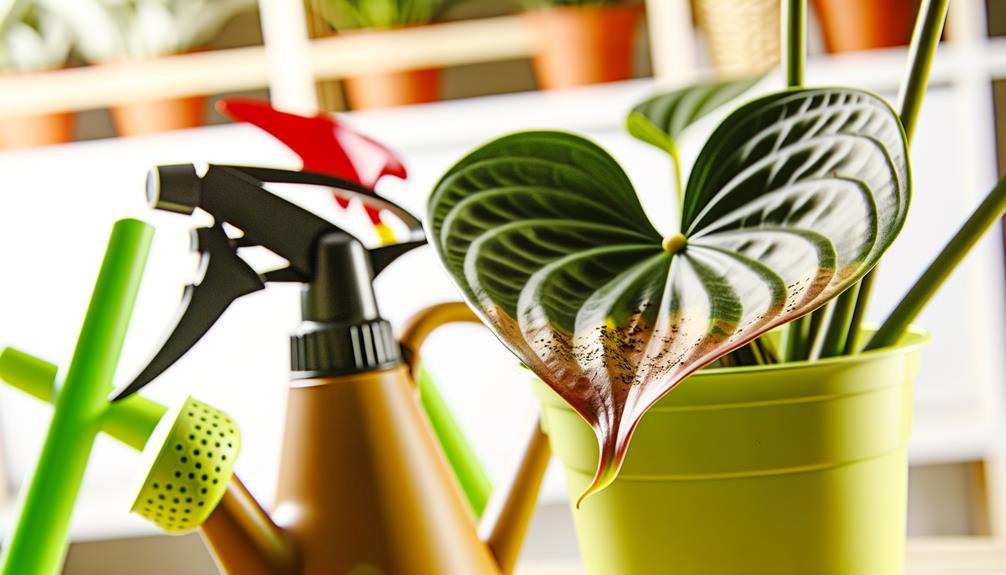
Key Takeaways
- Assess and adjust watering practices to avoid overwatering or underwatering.
- Increase humidity levels to between 70% and 80% to prevent leaf browning.
- Ensure the plant receives bright, indirect light to avoid light stress.
- Regularly prune dead or damaged leaves to encourage new growth.
- Inspect for pests and diseases, treating promptly if any are found.
Common Causes of Brown Leaves
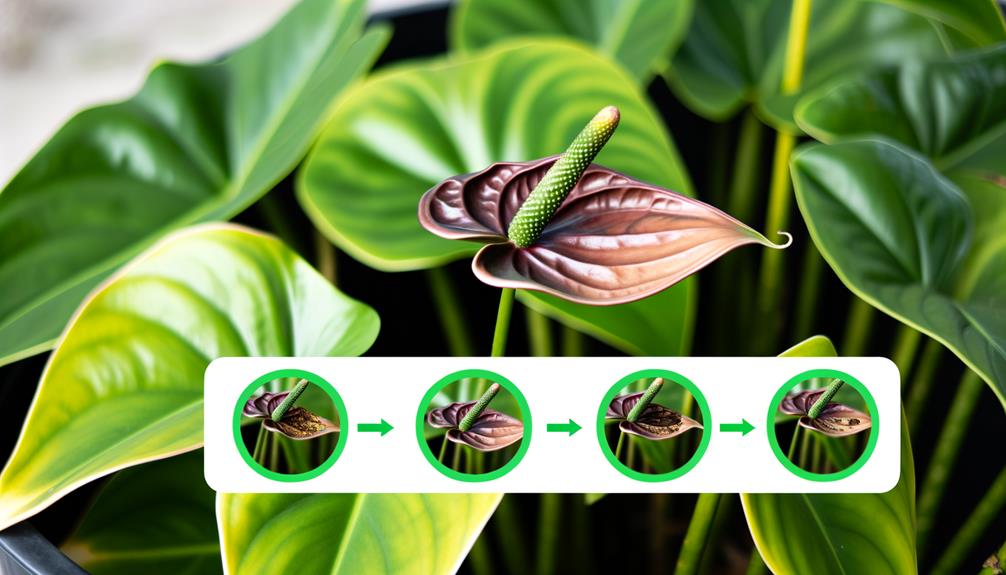
Several factors can cause brown leaves on your anthurium, including improper watering, low humidity, and inadequate light.
When the humidity drops below 60%, your anthurium struggles to retain moisture, leading to browning. You’ll want to use a hygrometer to monitor and maintain ideal humidity levels.
Inadequate light also stresses the plant. Anthuriums thrive in bright, indirect light; direct sunlight can scorch the leaves, while too little light inhibits growth. Make sure your plant is placed near a north or east-facing window.
Lastly, be cautious with temperature fluctuations. Keep the plant in a stable environment between 70-85°F, avoiding drafts and sudden temperature changes.
Monitoring these conditions will help you diagnose and correct the underlying issues efficiently.
Watering Techniques
To maintain healthy anthuriums, you need to establish a proper watering schedule that aligns with the plant’s specific requirements.
Monitor soil moisture levels consistently, ensuring the soil remains slightly damp but never waterlogged.
Use well-draining soil to prevent root rot, which can exacerbate leaf browning.
Proper Watering Schedule
Establishing a regular watering routine is crucial for maintaining the health of your anthuriums and preventing their leaves from turning brown. Water your anthuriums thoroughly but infrequently. Wait until the top inch of soil feels dry before you water again.
Typically, this means watering every 1-2 weeks, depending on your home’s humidity and temperature. Use room-temperature water to avoid shocking the plant. Make sure the pot has proper drainage to prevent root rot.
When you water, soak the soil evenly until water exits the drainage holes, then empty the saucer to avoid standing water. By adhering to this schedule, you’ll provide the consistent moisture anthuriums require, helping them thrive and keeping their leaves vibrant and healthy.
Soil Moisture Levels
Maintaining ideal soil moisture levels is fundamental for ensuring the health and vibrancy of your anthuriums. Begin by using well-draining soil to prevent waterlogging, which can cause root rot.
Check the soil’s moisture by inserting your finger about an inch deep; it should feel slightly damp, not soggy. Water your anthurium thoroughly when the top inch of soil is dry, ensuring excess water drains out.
Avoid letting the plant sit in standing water, as this can lead to fungal infections. Use room-temperature water to prevent shocking the roots. Consistency is key—fluctuating moisture levels can stress the plant.
Ideal Humidity Levels
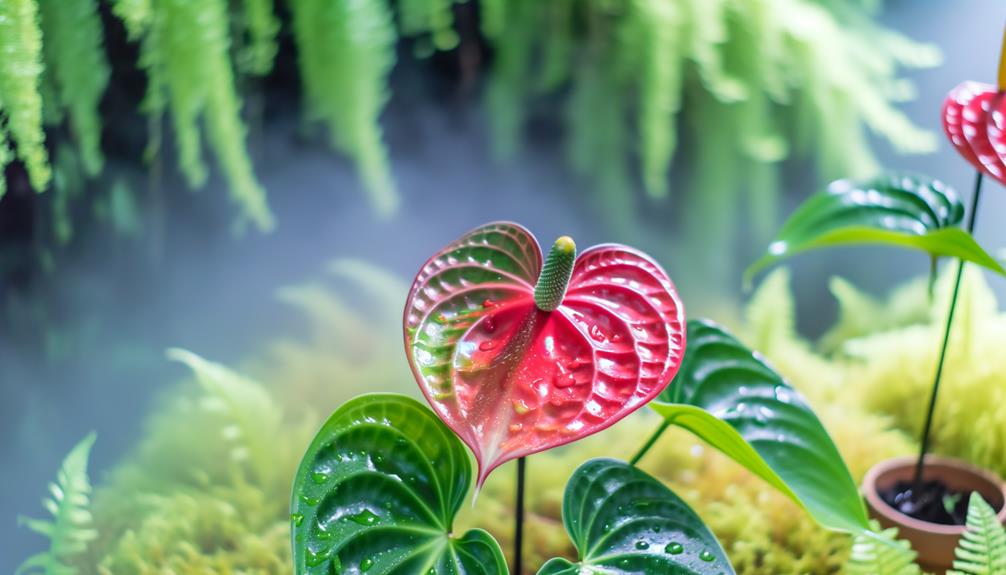
For anthuriums to thrive, make sure they’re in an environment where the humidity consistently stays between 70% and 80%. Maintaining this level of humidity prevents brown leaves and promotes healthy growth.
You can achieve this by following these steps:
- Use a Humidifier: Place a humidifier near your anthurium to maintain the ideal humidity levels. Choose a model with adjustable settings for precise control.
- Misting: Regularly mist the leaves with distilled water to mimic their natural habitat. Ensure the mist is fine to avoid waterlogging the soil.
- Humidity Trays: Set the pot on a tray filled with water and pebbles. As the water evaporates, it increases the moisture around the plant.
Proper Lighting
To maintain healthy anthuriums and prevent brown leaves, make sure they receive bright, indirect light. Avoid direct sunlight, as it can scorch the leaves and exacerbate browning.
Additionally, monitor the light duration, aiming for about 10-12 hours of consistent light each day.
Avoid Direct Sunlight
Anthuriums thrive best in bright, indirect sunlight, as direct exposure can cause their leaves to scorch and turn brown. To safeguard the health of your plant, you should take specific steps to shield it from harsh sunlight.
- Positioning: Place your Anthurium near a north or east-facing window, making sure it receives sufficient light without direct rays.
- Curtains or Blinds: Use sheer curtains or blinds to diffuse intense sunlight, preventing leaf damage.
- Artificial Lighting: Consider using grow lights if natural light is insufficient, setting them to mimic indirect sunlight.
Bright, Indirect Light
Why is bright, indirect light crucial for the ideal growth of your Anthurium? This type of lighting mimics their natural habitat, providing the right balance needed for peak photosynthesis without the risk of leaf scorch.
Position your Anthurium near a window where it receives filtered sunlight, or use sheer curtains to diffuse the light. Bright, indirect light encourages strong foliage and vibrant blooms while preventing the browning of leaves.
Avoid placing your plant in direct sunlight, which can cause cellular damage and stress. If natural light is insufficient, consider using grow lights that offer the right spectrum.
Proper lighting ensures your Anthurium thrives, maintaining its health and aesthetics, ultimately allowing you to serve others with a flourishing, beautiful plant.
Light Duration Matters
Securing your Anthurium receives the right duration of light is crucial for its best growth and overall health. Aim to provide 10-12 hours of bright, indirect light daily.
Inadequate light can lead to brown leaves, while too much direct light can scorch them. Use a timer to automate light exposure, especially if relying on artificial grow lights.
Here are three key steps:
- Monitor Light Levels: Use a light meter to optimize light intensity remains between 1000-2000 foot-candles.
- Adjust Placement: Position your Anthurium near an east or north-facing window for ideal light duration.
- Supplement with Grow Lights: During shorter days or in low-light environments, use full-spectrum grow lights to maintain the required light duration.
Adhering to these practices will guarantee your Anthurium thrives.
Soil and Drainage
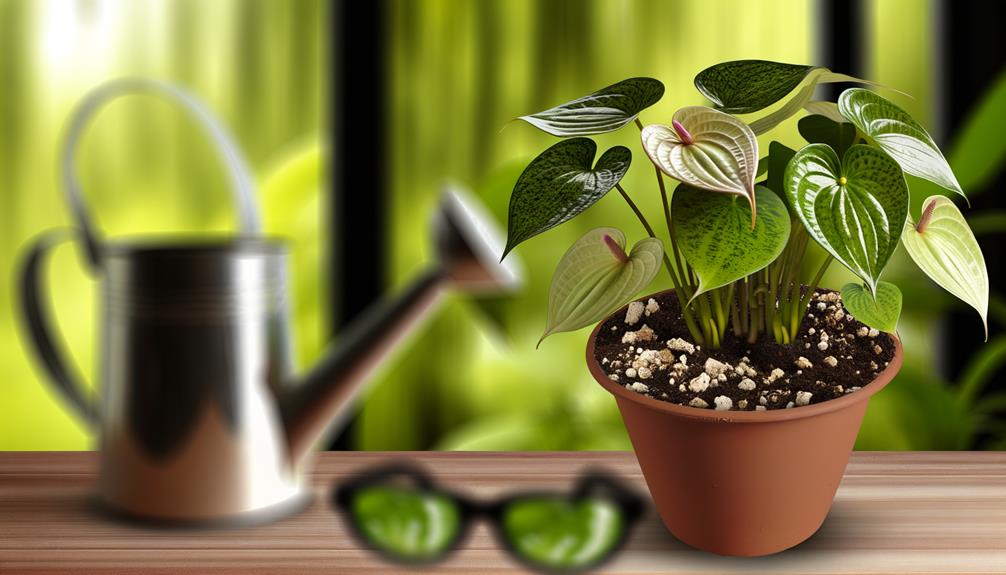
To prevent brown leaves, you need well-draining soil that retains some moisture without becoming waterlogged. Begin by using a mix specifically designed for tropical plants or create your own blend.
Combine equal parts of peat moss, pine bark, and perlite. This mixture guarantees good aeration and allows excess water to drain away.
| Ingredient | Function | Proportion |
|---|---|---|
| Peat Moss | Retains moisture | 1 part |
| Pine Bark | Enhances drainage | 1 part |
| Perlite | Improves aeration | 1 part |
Monitor your watering schedule closely. Water only when the top inch of soil feels dry. Confirm the pot has drainage holes to prevent root rot. By optimizing soil and drainage, you’ll create an environment where your anthurium thrives.
Fertilization Tips
Proper fertilization is necessary for maintaining the vibrant foliage and overall health of your anthurium. To guarantee your plant thrives, follow these detailed fertilization tips.
- Use a Balanced Fertilizer: Opt for a balanced, water-soluble fertilizer with an N-P-K ratio of 20-20-20. This guarantees your anthurium receives equal parts nitrogen, phosphorus, and potassium, promoting balanced growth.
- Dilution and Frequency: Dilute the fertilizer to half its recommended strength. Apply it every six to eight weeks during the growing season (spring and summer). Over-fertilization can lead to nutrient burn and brown leaves.
- Micronutrients: Make sure the fertilizer contains micronutrients like magnesium, iron, and calcium. These are essential for preventing deficiencies that may cause chlorosis and weakened foliage.
Temperature Requirements

Maintaining the correct temperature is equally vital for your anthurium’s health and can impact its vulnerability to brown leaves to a large extent. Aim to keep your anthurium in an environment where temperatures range between 65°F and 80°F (18°C to 27°C).
Avoid exposing it to temperatures below 50°F (10°C) or above 90°F (32°C). Sudden temperature fluctuations can stress the plant, leading to brown leaves. Ensure the plant isn’t located near drafts, heating vents, or air conditioners.
Additionally, maintain consistent humidity levels by placing a humidity tray or using a humidifier. By controlling the temperature and humidity, you’re creating an ideal environment for your anthurium, considerably reducing the chances of brown leaves and promoting overall health.
Pest Control
Identifying and managing pests is crucial for keeping your anthurium healthy and preventing brown leaves. Common pests like spider mites, aphids, and mealybugs can wreak havoc on your plants.
Here’s how to tackle them:
- Inspection: Regularly check your anthurium for signs of pests. Look for tiny webs, sticky residue, or small, moving insects on the leaves and stems.
- Treatment: Use insecticidal soap or neem oil to address infestations. Ensure thorough coverage, especially on the undersides of leaves where pests often hide.
- Prevention: Maintain proper humidity levels and avoid over-fertilizing, as these conditions can attract pests. Quarantine new plants to prevent introducing pests to your collection.
Disease Management

Combating diseases in anthuriums demands keen observation and a proactive approach to guarantee your plants remain vibrant and healthy. Start by regularly inspecting leaves for signs of fungal infections like leaf spot or blight, characterized by brown or yellow lesions.
Ensure proper air circulation around your plants to reduce humidity levels, which can foster pathogenic growth. Use sterilized pruning tools to remove infected leaves immediately, preventing disease spread. Apply a fungicide specifically designed for anthuriums, following the manufacturer’s instructions meticulously.
Keep your plants’ environment clean by removing debris and old foliage. Water your anthuriums at the base, avoiding wetting the leaves, and improve drainage to prevent root rot. By remaining vigilant, you’ll effectively manage disease and promote robust plant health.
Pruning and Maintenance
To guarantee your anthuriums thrive, regularly prune dead or damaged leaves using disinfected tools to promote healthy growth and prevent disease. This practice ensures the plant’s energy is directed towards healthy foliage and new growth.
Use sharp scissors or pruning shears, disinfected with alcohol, to make clean cuts close to the base of the leaf stem.
Here’s a detailed approach:
- Inspect Regularly: Check your anthuriums every week for any signs of browning or yellowing leaves.
- Disinfect Tools: Before and after pruning, disinfect your tools to prevent the spread of pathogens.
- Prune Strategically: Remove leaves that are more than 50% damaged, focusing on those with significant brown spots or edges.
Recovery Steps

To start the recovery process for your Anthurium, first assess your watering practices, ensuring the soil remains moist but never waterlogged.
Next, optimize light conditions by placing the plant in a spot with bright, indirect sunlight, as direct sunlight can scorch the leaves.
These adjustments will help restore your Anthurium’s health and reduce the occurrence of brown leaves.
Assess Watering Practices
Start by evaluating the frequency and amount of water you provide to make sure your anthurium isn’t suffering from overwatering or underwatering. Consistent moisture is essential, but so is avoiding waterlogged soil.
Follow these steps:
- Check Soil Moisture: Insert your finger about an inch into the soil. If it feels dry, it’s time to water. If it’s still moist, wait a few days.
- Watering Schedule: Water your anthurium once a week during the growing season and reduce frequency in winter. Adjust based on your plant’s environment.
- Drainage: Guarantee your pot has drainage holes. Excess water should flow out freely to prevent root rot.
Optimize Light Conditions
After confirming your anthurium’s watering needs are met, focus on providing the best light conditions to aid in its recovery from brown leaves.
Position your anthurium in a location where it can receive bright, indirect light. Direct sunlight can scorch the leaves, worsening the browning issue. If natural light is inadequate, consider using a grow light to supplement. Keep the light source 12-18 inches away to prevent overheating.
Monitor your plant’s response to the light changes over a few weeks. If you notice new, healthy growth, you’re on the right path. Always rotate the plant periodically to guarantee even light distribution.
Conclusion
By mastering these expert techniques, you’ll transform your struggling anthuriums into the epitome of botanical perfection.
Imagine leaves so vibrant they could outshine the finest emeralds, all because you’ve fine-tuned your watering, humidity, lighting, and soil to unparalleled precision.
You’ve become a pest-control guru and a disease-management wizard. Pruning? You’re practically an artist.
With these recovery steps, your anthuriums won’t just survive—they’ll thrive like never before, becoming the envy of every green thumb around.

